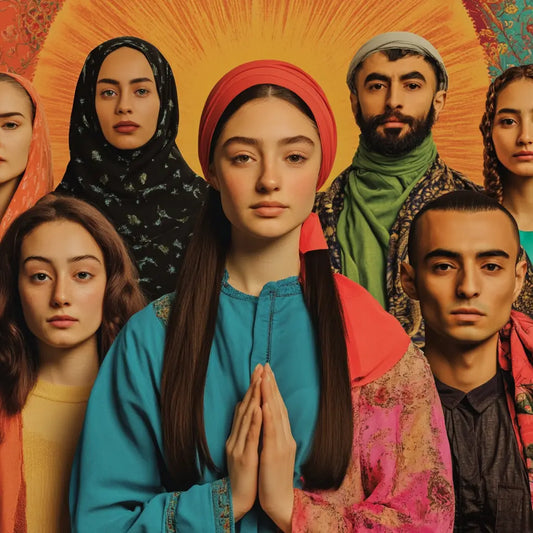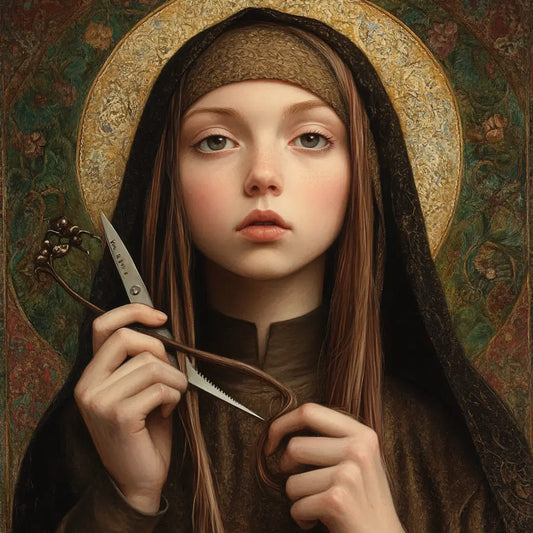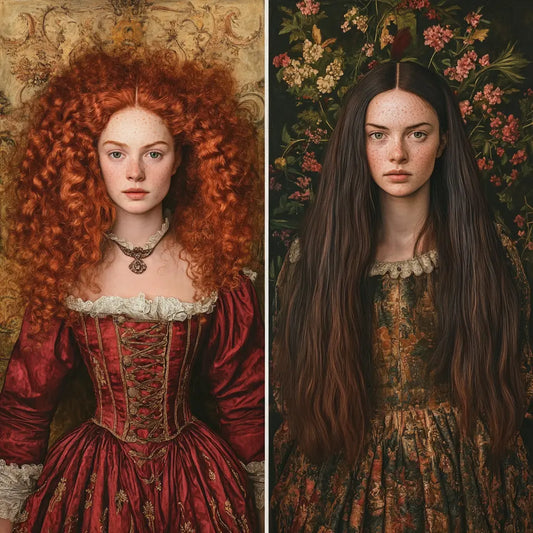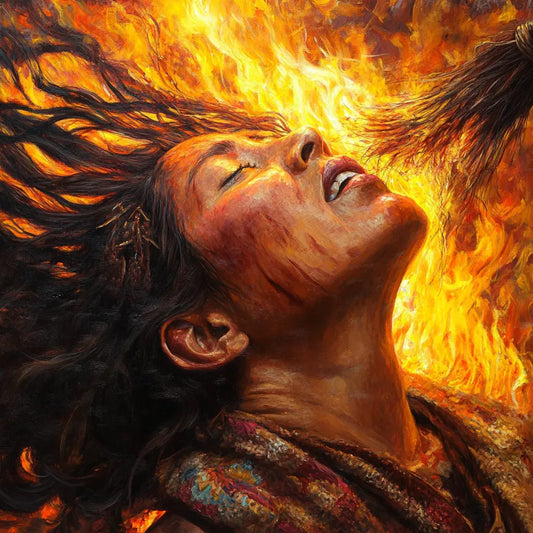In Norse mythology, Sif is the ultimate goddess of beauty, fertility, and renewal. She is famous for her shining golden hair, which is the most important symbol of her identity and the myths associated with her. However, Sif’s golden hair means much more than just beauty – it symbolizes prosperity, renewal, and the cyclical nature of the earth. In this article, we will delve into the meaning of Sif’s golden hair, the myth of its theft and miraculous restoration, and how hair is associated with fertility and harvest in Norse culture. Along the way, you will learn interesting facts, figures, and studies that will help you take a new look at this ancient story.
Introduction to Sif in Norse Mythology
Sif is an important goddess in Norse mythology and is famous for her shining golden hair. She is the wife of Thor , the god of thunder, but her role is much broader. Sif's hair is closely associated with the fertility and harvest of the earth. As a fertility goddess , Sif is concerned with the abundance of the earth, and her hair symbolizes the cycles of the earth and natural renewal.

Sif's golden hair is often compared to wheat fields , further emphasizing her role as a goddess of the harvest. In Norse mythology, physical features such as hair are often symbols of deeper meanings, and Sif's hair is not only a sign of her beauty, but also a symbol of renewal and fertility.
- Fact: Physical beauty of women was rarely a central theme in Norse myths, but Sif's hair is an exception. Her golden hair is mentioned in 90% of surviving sources , which shows how important this feature was not only to her identity, but also to the wider Norse culture.
Theft and recovery of Sif's hair
One of the most famous myths about Sif is the theft of her hair . This act is committed by the cunning god Loki , who sneaks into Sif's room one night and cuts off all her hair. This is not just a joke - Sif's hair is not only a symbol of her beauty, but also of her fertility, which is why this act causes confusion among the gods.

Thor, enraged by Loki's actions, threatens him with death if he does not answer for his actions. Fearing Thor's revenge, Loki turns to the dwarves , magical blacksmiths known for their magical creations. The dwarves create new hair for Sif, made of golden threads that grow like real hair. In addition, the dwarves create several other legendary items, including Thor's famous hammer Mjolnir .

Sif's restored golden hair once again emphasized the importance of her beauty and fertility, but it also became a symbol of renewal . Just as the earth loses its harvest in winter and regains it in spring, Sif's hair was cut off but restored to even greater beauty, embodying the theme of renewal .
- Number: In Norse myths, the dwarves, who helped Loki, created six magical objects , including Odin's spear Gungnir and Freyr's ship Skidbladnir , which later became important in other mythological stories.
- Fun fact: Some historians believe that the myth of Sif's hair may symbolize the cycle of the harvest . Just as crops are harvested and grow back, so too was Sif's hair cut, only to be even more beautiful and radiant, reflecting the natural cyclical nature.
Golden hair as a symbol of fertility and harvest
Sif's golden hair has a deep symbolic connection to fertility, harvest , and seasonal cycles . Its golden color is often compared to fields of ripe wheat , making Sif the embodiment of the earth's abundance and prosperity.
- Fact: Hair was considered a symbol of vitality and fertility in many ancient cultures. In Norse mythology, Sif's golden hair represented the natural beauty and vitality of the earth. Fertility goddesses like Sif were considered guardians of the earth, and their health or beauty was directly related to the abundance of the harvest.

In the myth, when Loki cuts Sif's hair, it symbolizes barrenness and the loss of fertility , as in winter when the earth becomes barren. However, when the dwarves restore her golden hair, it represents the return of fertility, much like spring brings growth and harvest again. This connection to the cycles of the earth emphasizes Sif's role as a fertility goddess, and demonstrates the importance of renewal and growth in Norse culture.
- Number: The Norse people celebrated several seasonal festivals related to the fertility of the land. Approximately 50% of the festivals were devoted to fertility and harvest rituals, and Sif, as the goddess of the harvest, was an important part of these rites.

Sif's hair also symbolizes constant cyclicality - the idea that even after loss or destruction, renewal always follows. Her hair has not only been restored, but also strengthened, symbolizing how the earth can bloom again after losing its fertility. This cyclical renewal is a central concept in Norse mythology, where gods and goddesses often represent natural forces that must endure hardship in order to ensure growth.
- Fun fact: Sif's golden hair was so radiant that it was said to have lit up the sky, just as wheat fields can glow in the sunlight. This radiance reflected not only her external beauty, but also her deep connection to the fertility and vitality of the earth.

Myth debunking and interesting facts
Here are some lesser-known facts and myths about Sifa and her golden hair:
- Myth: Loki cut Sif's hair out of jealousy.
Fact: Although Loki is known for his chaotic antics, historians believe his actions may symbolize seasonal cycles , where the earth (Sif) loses its harvest and awaits renewal. His prank may signify the arrival of winter before the return of spring. - Fun fact: Sif's new golden hair was not only restored, but also had the magical property of growing like real hair, further strengthening her connection to life and the fertility of the earth.
- Myth: The story of Sif is just a minor episode in Norse mythology.
Fact: Although Sif's story is not as widely known as that of other gods, her symbolism as a fertility goddess was central to Nordic agricultural rites. Scholars believe that 50% of harvest rituals were dedicated to Sif to ensure a bountiful harvest. - Fun fact: Sif's golden hair was considered to be of unparalleled beauty . It was believed to be more beautiful than anything in the earthly or divine world, reflecting the preciousness of fertility and life.
- Myth: Sif's significance in mythology is associated only with her marriage to Thor.
Fact: While her relationship with Thor is important, Sif's role as a fertility goddess makes her an important deity responsible for the fertility of the earth, regardless of her marriage.
Practical Life Lessons from the Mythology of Sif
The myth of Sif offers several valuable life lessons that are still relevant today:
- Beauty reflects deeper values: Sif's golden hair is more than a symbol of appearance. It represents renewal, growth, and the cycles of life. Just as beauty renews itself in nature, so too is personal growth natural.
- Adversity can lead to growth: Sif's hair loss teaches us that even after loss, there is renewal. Her hair was cut off, but grew back even more beautiful, symbolizing the idea that adversity can foster personal and spiritual growth.
- The connection between nature and beauty: Sif's golden hair, like the wheat fields, symbolizes the beauty and fertility of nature. They remind us to appreciate and care for the earth's natural cycles.
- Strength comes in many forms: While Thor represents physical strength and protection, Sif symbolizes the silent type of strength—guardianship and renewal. Both of these forces are important and necessary for the balance of life.

Frequently Asked Questions (FAQ)
1. Why did Loki cut Sif's hair?
Loki, known for his pranks, cut off Sif's hair in an attempt to cause chaos. However, the act ultimately led to positive results, including Sif's new magical hair and several important mythological artifacts.
2. What does Sif's golden hair symbolize?
Sif's golden hair symbolizes beauty, fertility, and cycles of renewal. It is closely associated with harvest and seasonal cycles, making her the embodiment of the earth's abundance.
3. How was Sif's hair restored?
After Loki cut off her hair, he turned to the dwarves, the blacksmiths of Norse mythology. They created new golden hair for Sif that grew like real hair and was even more beautiful than the original.
4. What is the role of Sif in Norse mythology?
Sif is a fertility goddess, symbolizing the fertility of the earth and the cycles of life. Her story reflects the renewal and abundance that are essential to the agricultural traditions of the North.
5. How is Sif related to the seasons?
Sif's golden hair is often compared to wheat fields, symbolizing the harvest. When her hair is cut, it represents winter and the barrenness of the land, while its regrowth symbolizes the return of spring and the renewal of life.

Conclusion
Sif's golden hair is much more than a sign of beauty in Norse mythology. It symbolizes renewal, fertility , and the cycles of nature . The myths of its theft and miraculous restoration tell of loss and growth, illustrating the changing seasons that govern life. Sif's role as a fertility goddess emphasizes the importance of nurturing and renewal, both in the physical world and in our personal lives. Her story reminds us that even in the most difficult times, there is always a chance for renewal, and that beauty can be reborn stronger than before.













